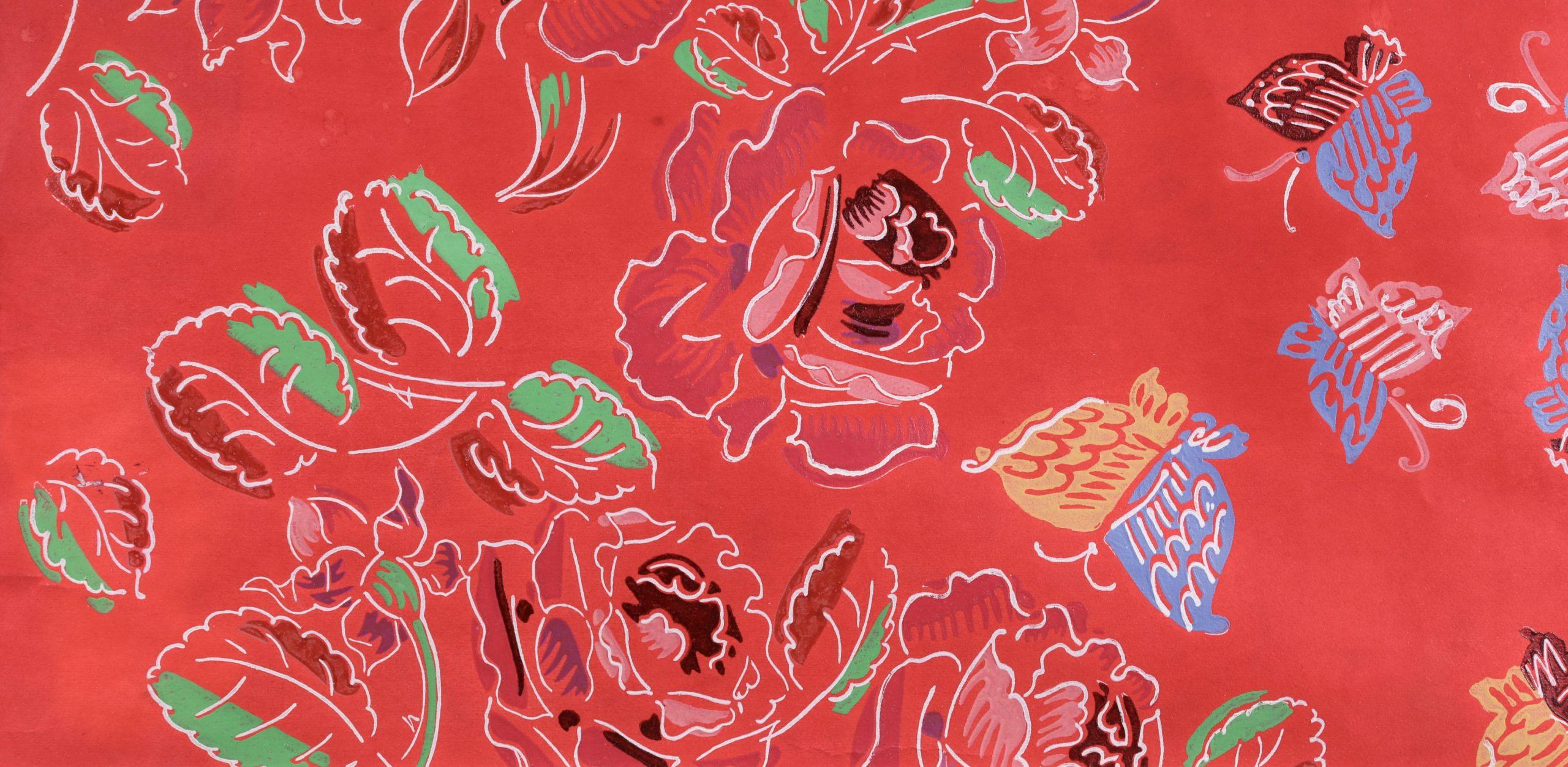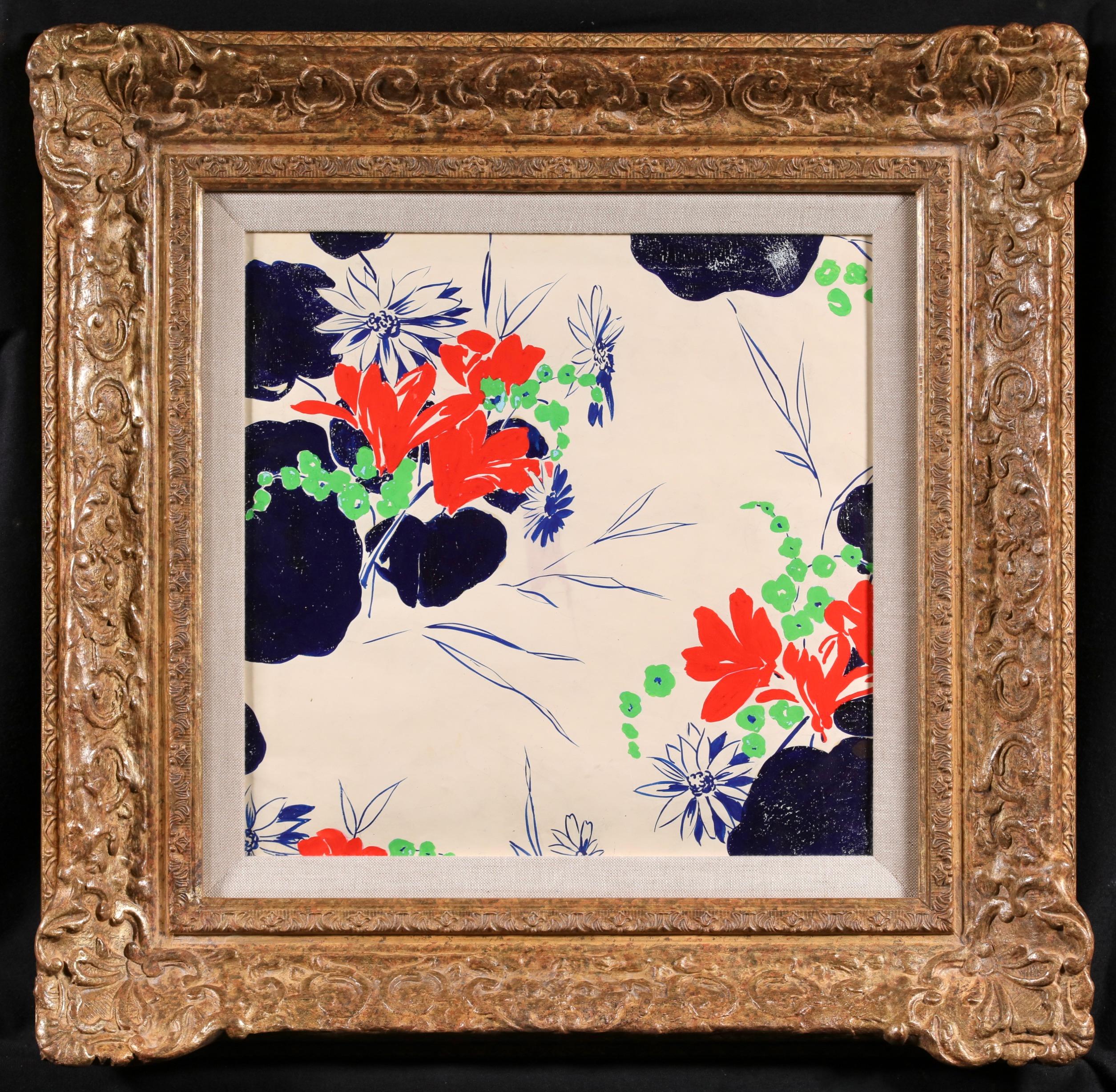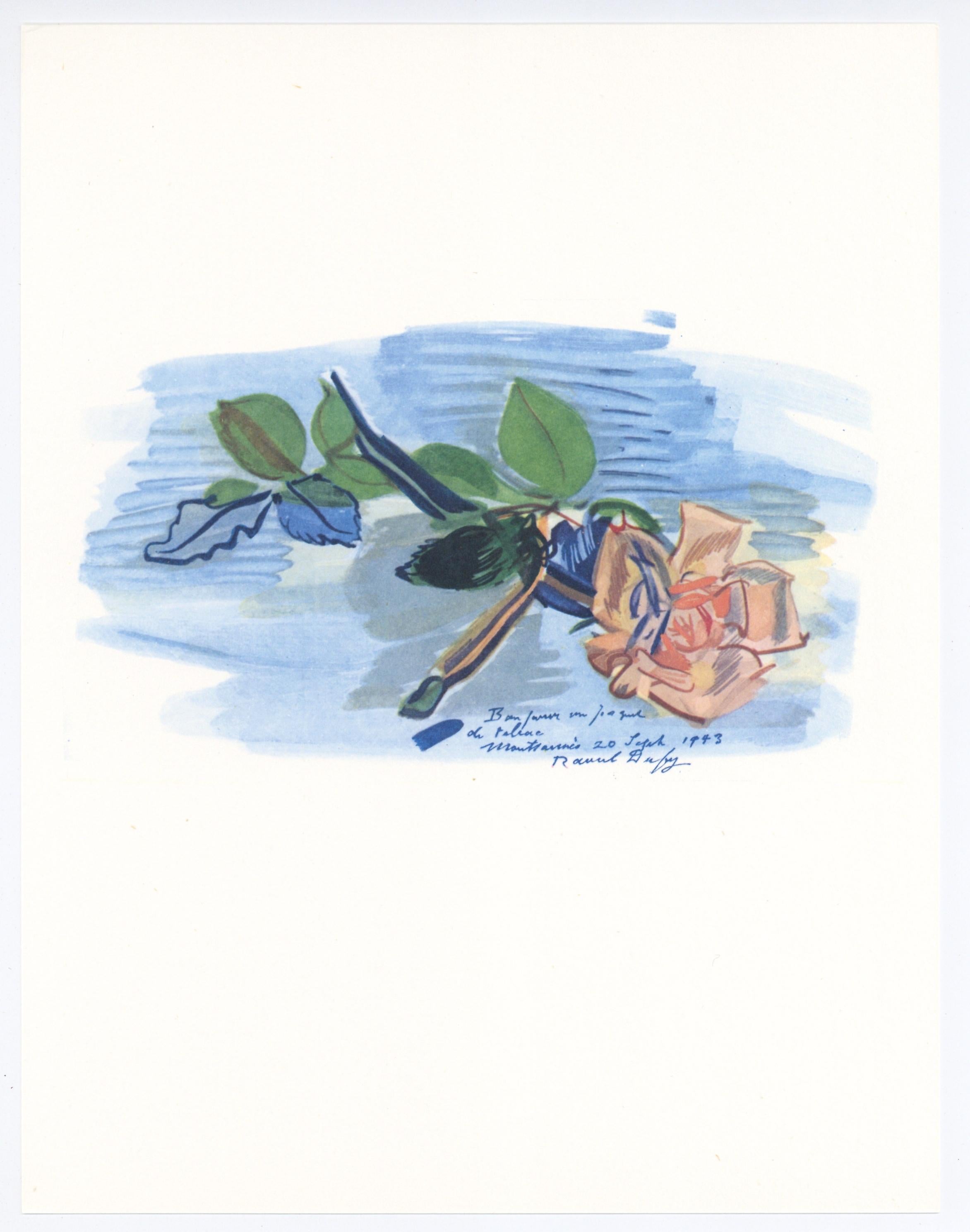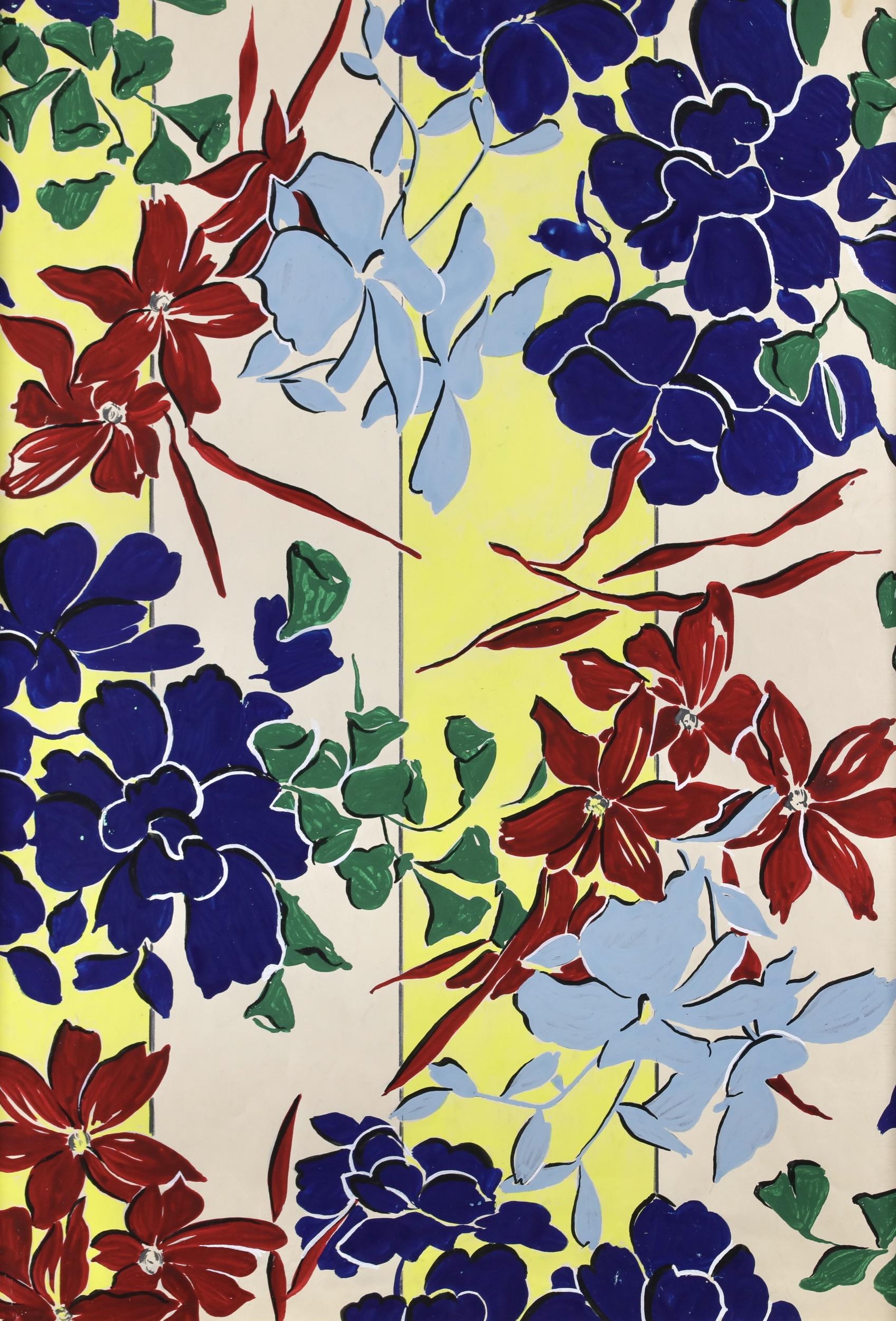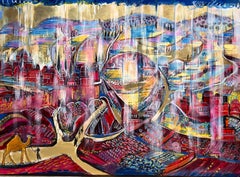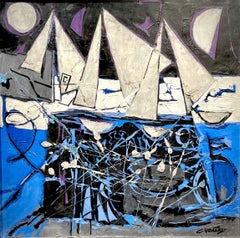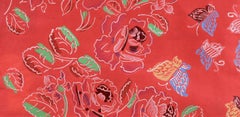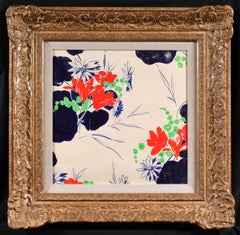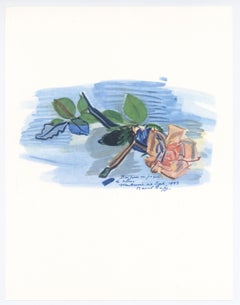Items Similar to Beautiful watercolor drawing of Roses by the well known French artist Jean Dufy
Want more images or videos?
Request additional images or videos from the seller
1 of 7
Jean DufyBeautiful watercolor drawing of Roses by the well known French artist Jean Dufy
$4,150
£3,172.90
€3,654.54
CA$5,815.42
A$6,492.37
CHF 3,401.91
MX$79,473.01
NOK 43,204.23
SEK 40,736.11
DKK 27,274.17
Shipping
Retrieving quote...The 1stDibs Promise:
Authenticity Guarantee,
Money-Back Guarantee,
24-Hour Cancellation
About the Item
Accompanied by a certificate of authenticity signed by Mr. Jacques Bailly dated June 23, 2016.
This beautiful watercolor drawing of roses by Jean Dufy captures the elegance and vibrancy of the delicate flowers through the artist’s distinctive style. Jean Dufy, known for his mastery in capturing the beauty of nature, particularly flowers, infuses this piece with a sense of movement and life. His delicate brushstrokes bring the roses to life, with soft and flowing lines that emphasize the petals’ gentle curves and the subtle transitions of color.
Dufy, who was influenced by the Impressionist movement, employs a light, fluid approach to color, creating a dreamy, almost ethereal atmosphere. The watercolor technique lends itself perfectly to the softness and transparency of the flowers, allowing the light to shine through and highlighting the intricate details of each petal.
The roses in this drawing are not merely depicted as still life; instead, they exude a sense of freshness and natural beauty, evoking emotions and a deep connection to the organic world. Dufy’s characteristic use of vibrant hues, combined with his unique interpretation of form, makes this piece not just a representation of flowers, but a celebration of nature’s grace and elegance.
This work by Jean Dufy is a fine example of his artistic skill and his ability to transform simple subjects into timeless works of art. It remains a cherished piece for collectors and art enthusiasts, showcasing the beauty of roses through the eyes of one of the 20th century’s most beloved artists.
- Creator:Jean Dufy (1888 - 1964, French)
- Dimensions:Height: 23.63 in (60 cm)Width: 21.26 in (54 cm)
- Medium:
- Period:
- Condition:
- Gallery Location:Jerusalem, IL
- Reference Number:Seller: 52000/2701stDibs: LU2068215525482
Jean Dufy
Jean Dufy was a French Art Deco artist, best known for his colourful, melodic depictions of post-war Parisian society. Working to capture everyday life, from concert halls and circuses to country landscapes and busy Parisian streets, Dufy focused on recreating the feeling and impression of a scene, rather than individual details. In 1906, Dufy visited the exhibition ‘Cercle de l’Art Moderne’ in La Havre, and it was this show that eventually inspired him to pursue an artistic career. The exhibit, one of Dufy’s first exposures to Modern Art, crucially shaped his approach to art and introduced him to artists such as Picasso and Matisse. While he had no formal training, his older brother was well-known French Fauvist Raoul Dufy, who served as his artistic mentor. In January 1914, Dufy launched his artistic career, holding his first show at Galerie Berthe Weil. He returned to Paris after the war and settled in the Montmartre district of Paris, moving next door to artist George Braque, who encouraged Dufy to experiment with Cubism. His personal painting style developed into a vibrant fusion of Post-Impressionism with a loose decorative approach to colour and line, which he achieved from his work in porcelain design. For almost 30 years, Dufy worked for Limoge porcelain manufacturer Theodore Haviland, hand-painting decorative designs of animals and flowers. At the 1925 L’exposition Internationale des Arts Décoratifs he was awarded a gold medal for designing the service ‘Châteaux de France’. Dufy participated in many exhibitions, including the Salon d’Automne, which reflected the popularity of jazz music and the art of Parisian culture after the war. Dufy would return to his native Normandy throughout his life and spent long stretches of time in the south of France. The dynamism of these landscapes and cityscapes - particularly noticeable in the street scene Route de Rives (Touraine)- are so cleverly captured due to Dufy’s uniquely musical and distinctive Post-Impressionistic style.
About the Seller
5.0
Vetted Professional Seller
Every seller passes strict standards for authenticity and reliability
1stDibs seller since 2022
11 sales on 1stDibs
- ShippingRetrieving quote...Shipping from: Jerusalem, Israel
- Return Policy
Authenticity Guarantee
In the unlikely event there’s an issue with an item’s authenticity, contact us within 1 year for a full refund. DetailsMoney-Back Guarantee
If your item is not as described, is damaged in transit, or does not arrive, contact us within 7 days for a full refund. Details24-Hour Cancellation
You have a 24-hour grace period in which to reconsider your purchase, with no questions asked.Vetted Professional Sellers
Our world-class sellers must adhere to strict standards for service and quality, maintaining the integrity of our listings.Price-Match Guarantee
If you find that a seller listed the same item for a lower price elsewhere, we’ll match it.Trusted Global Delivery
Our best-in-class carrier network provides specialized shipping options worldwide, including custom delivery.More From This Seller
View AllVase of flowers oil colorful figurative painting
Located in Jerusalem, IL
oil on canvas signed by the artist.
This work will be included in “Volume IV and Additives to Volumes I, II and III” of the Catalogue Rasionne currently in preparation by Marc Ottavi...
Category
1940s Paintings
Materials
Oil, Canvas
acrylic on canvas colorful Sheep in landscape figurative by Menashe Kadishman
By Menashe Kadishman
Located in Jerusalem, IL
acrylic on canvas colorful Sheep in landscape figurative painting by the Israeli famous artist Menashe Kadishman.
Category
2010s Paintings
Materials
Canvas, Acrylic
The road to Jerusalem colorful acrylic painting, gold abstract in red and pink
Located in Jerusalem, IL
gold leaf, acrylic and lacquer on board. very colorful work in pink and red. described the road to Jerusalem. Jerusalem of gold.
Category
21st Century and Contemporary Abstract Paintings
Materials
Acrylic, Board
Beautiful and big oil on canvas painting Composition in Blue colors by Venard
By Claude Venard
Located in Jerusalem, IL
Beautiful and big 100X100 cm oil on canvas painting Composition in Blue colors by the well known French artist Claude Venard. the painting is showing white sails and nets.
Category
Late 20th Century Paintings
Materials
Canvas, Oil
Song of Jerusalem, Mima'amakim
Located in Jerusalem, IL
Touvia b.1980 (Israeli) - SONG OF JERUSALEM - gold leaf, acrylic and lacquer on board
Tradition teaches that the 7 colors of the rainbow parallel 7 shades that the soul illuminates ...
Category
21st Century and Contemporary Abstract Mixed Media
Materials
Acrylic, Board
A spectacular colorful painting of the Western Wall with gold leaf
Located in Jerusalem, IL
In this evocative work, artist Sergei Moskalev captures the spiritual essence and vibrant energy of the Western Wall (Kotel) in Jerusalem. Rendered in dynamic, expressive brushstroke...
Category
21st Century and Contemporary Landscape Paintings
Materials
Gold Leaf
You May Also Like
Fleurs et Papillons - Fauvist Flowers Watercolor & Gouache by Raoul Dufy
By Raoul Dufy
Located in Marlow, Buckinghamshire
Botanical watercolour and gouache on paper circa 1920 by French fauvist painter Raoul Dufy. The work depicts flowers in red and butterflies in blues, yellows, black and white. This work was executed by Dufy as a fabric design.
Dimensions:
Framed: 17"x27"
Unframed: 10"x20"
Provenance:
Private collection of works by Raoul Dufy for Bianchini Ferier
Bianchini Ferrier Collection - Christie's London - July 2001
SF Fall Show
Raoul Dufy was one of a family of nine children, including five sisters and a younger brother, Jean Dufy, also destined to become a painter. Their father was an accountant in the employ of a major company in Le Havre. The Dufy family was musically gifted: his father was an organist, as was his brother Léon, and his youngest brother Gaston was an accomplished flautist who later worked as a music critic in Paris. Raoul Dufy's studies were interrupted at the age of 14, when he had to contribute to the family income. He took a job with an importer of Brazilian coffee, but still found time from 1892 to attend evening courses in drawing and composition at the local college of fine arts under Charles Marie Lhullier, former teacher of Othon Friesz and Georges Braque. He spent his free time in museums, admiring the paintings of Eugène Boudin in Le Havre and The Justice of Trajan in Rouen. A municipal scholarship enabled him to leave for Paris in 1900, where he lodged initially with Othon Friesz. He was accepted by the École des Beaux-Arts, where he studied under Léon Bonnat, whose innate conservatism prompted Dufy to remark later that it was 'good to be at the Beaux-Arts providing one knew one could leave'.
And leave he did, four years later, embarking with friends and fellow students on the rounds of the major Paris galleries - Ambroise Vollard, Durand-Ruel, Eugène Blot and Berheim-Jeune. For Dufy and his contemporaries, Impressionism represented a rejection of sterile academism in favour of the open-air canvases of Manet, the light and bright colours of the Impressionists, and, beyond them, the daringly innovative work of Gauguin and Van Gogh, Seurat, Cézanne, Toulouse-Lautrec and others. Dufy was an out-and-out individualist, however, and was not tempted to imitate any of these artists. He produced, between 1935 and 1937, Fée Electricité (Spirit of Electricity), the emblem for the French utilities company Electricité de France (EDF).
Dufy visited the USA for the first time in 1937, as a member of the Carnegie Prize jury. In 1940, the outbreak of war (and his increasingly rheumatic condition) persuaded him to settle in Nice. When he eventually returned to Paris 10 years later, his rheumatism had become so debilitating that he immediately left for Boston to follow a course of pioneering anti-cortisone treatment. He continued working, however, spending time first in Harvard and then in New York City before moving to the drier climate of Tucson, Arizona. The cortisone treatment was by and large unsuccessful, although he did recover the use of his fingers. He returned to Paris in 1951 and decided to settle in Forcalquier, where the climate was more clement. Within a short time, however, he was wheelchair-bound. He died in Forcalquier in March 1953 and was buried in Cimiez.
Between 1895 and 1898, Raoul Dufy painted watercolours of landscapes near his native Le Havre and around Honfleur and Falaise. By the turn of the century, however, he was already painting certain subjects that were to become hallmarks of his work - flag-decked Parisian cityscapes, Normandy beaches teeming with visitors, regattas and the like, including one of his better-known early works, Landing Stage at Ste-Adresse. By 1905-1906 Friesz, Braque, Matisse, Derain, Vlaminck, Van Dongen and Rouault were described collectively as Fauves (the wild beasts). What they had in common was a desire to innovate, but they felt constrained nonetheless to meet formally to set out the guiding principles of what promised to be a new 'movement'. Dufy quickly established that those principles were acceptable; moreover, he was most impressed by one particular painting by Henri Matisse ( Luxury, Calm and Voluptuousness) which, to Dufy, embodied both novelty and a sense of artistic freedom. Dufy promptly aligned himself with the Fauves. Together with Albert Marquet in particular, he spent his time travelling the Normandy coast and painting views similar...
Category
1920s Fauvist Still-life Drawings and Watercolors
Materials
Paper, Watercolor, Gouache
Bouquet of Roses - Original ink drawing, Signed
By Jean Dufy
Located in Paris, IDF
Jean DUFY (1888-1964)
Bouquet of Roses
Original ink and lavish drawing
Signed with the artist stamp
On paper 29 x 36 cm (c. 12 x 14 in)
Very good condition, paper lightly yellowed
Category
Mid-20th Century Modern Still-life Drawings and Watercolors
Materials
India Ink
Projet de Tissus - Fauvist Flowers Watercolor & Gouache by Raoul Dufy
By Raoul Dufy
Located in Marlow, Buckinghamshire
Botanical watercolour and gouache on paper circa 1920 by French fauvist painter Raoul Dufy. The work depicts flowers in red, blue and green. This work was executed by Dufy as a fabric design.
Dimensions:
Framed: 19.5"x19.5"
Unframed: 12"x12"
Provenance:
Private collection of works by Raoul Dufy for Bianchini Ferier
Bianchini Ferrier Collection - Christie's London - July 2001
SF Fall Show
Raoul Dufy was one of a family of nine children, including five sisters and a younger brother, Jean Dufy, also destined to become a painter. Their father was an accountant in the employ of a major company in Le Havre. The Dufy family was musically gifted: his father was an organist, as was his brother Léon, and his youngest brother Gaston was an accomplished flautist who later worked as a music critic in Paris. Raoul Dufy's studies were interrupted at the age of 14, when he had to contribute to the family income. He took a job with an importer of Brazilian coffee, but still found time from 1892 to attend evening courses in drawing and composition at the local college of fine arts under Charles Marie Lhullier, former teacher of Othon Friesz and Georges Braque. He spent his free time in museums, admiring the paintings of Eugène Boudin in Le Havre and The Justice of Trajan in Rouen. A municipal scholarship enabled him to leave for Paris in 1900, where he lodged initially with Othon Friesz. He was accepted by the École des Beaux-Arts, where he studied under Léon Bonnat, whose innate conservatism prompted Dufy to remark later that it was 'good to be at the Beaux-Arts providing one knew one could leave'.
And leave he did, four years later, embarking with friends and fellow students on the rounds of the major Paris galleries - Ambroise Vollard, Durand-Ruel, Eugène Blot and Berheim-Jeune. For Dufy and his contemporaries, Impressionism represented a rejection of sterile academism in favour of the open-air canvases of Manet, the light and bright colours of the Impressionists, and, beyond them, the daringly innovative work of Gauguin and Van Gogh, Seurat, Cézanne, Toulouse-Lautrec and others. Dufy was an out-and-out individualist, however, and was not tempted to imitate any of these artists. He produced, between 1935 and 1937, Fée Electricité (Spirit of Electricity), the emblem for the French utilities company Electricité de France (EDF).
Dufy visited the USA for the first time in 1937, as a member of the Carnegie Prize jury. In 1940, the outbreak of war (and his increasingly rheumatic condition) persuaded him to settle in Nice. When he eventually returned to Paris 10 years later, his rheumatism had become so debilitating that he immediately left for Boston to follow a course of pioneering anti-cortisone treatment. He continued working, however, spending time first in Harvard and then in New York City before moving to the drier climate of Tucson, Arizona. The cortisone treatment was by and large unsuccessful, although he did recover the use of his fingers. He returned to Paris in 1951 and decided to settle in Forcalquier, where the climate was more clement. Within a short time, however, he was wheelchair-bound. He died in Forcalquier in March 1953 and was buried in Cimiez.
Between 1895 and 1898, Raoul Dufy painted watercolours of landscapes near his native Le Havre and around Honfleur and Falaise. By the turn of the century, however, he was already painting certain subjects that were to become hallmarks of his work - flag-decked Parisian cityscapes, Normandy beaches teeming with visitors, regattas and the like, including one of his better-known early works, Landing Stage at Ste-Adresse. By 1905-1906 Friesz, Braque, Matisse, Derain, Vlaminck, Van Dongen and Rouault were described collectively as Fauves (the wild beasts). What they had in common was a desire to innovate, but they felt constrained nonetheless to meet formally to set out the guiding principles of what promised to be a new 'movement'. Dufy quickly established that those principles were acceptable; moreover, he was most impressed by one particular painting by Henri Matisse ( Luxury, Calm and Voluptuousness) which, to Dufy, embodied both novelty and a sense of artistic freedom. Dufy promptly aligned himself with the Fauves. Together with Albert Marquet in particular, he spent his time travelling the Normandy coast and painting views similar...
Category
1920s Fauvist Still-life Drawings and Watercolors
Materials
Paper, Watercolor, Gouache
Les roses coupees
By (after) Raoul Dufy
Located in Henderson, NV
Medium: offset lithograph (after the watercolor). Printed in 1970 on velin bouffant paper from the Papeteries Casteljoux and published in France by Edito-Service Geneve. This reprodu...
Category
1970s Prints and Multiples
Materials
Offset
Projet de Fleurs - Fauvist Flowers Gouache by Raoul Dufy
By Raoul Dufy
Located in Marlow, Buckinghamshire
Botanical gouache on paper circa 1920 by French fauvist painter Raoul Dufy. The work flowers in red and blues with green foliage against a yellow and white stripped background.
Dimensions:
Framed: 25"x20"
Unframed: 18"x13"
Raoul Dufy was one of a family of nine children, including five sisters and a younger brother, Jean Dufy, also destined to become a painter. Their father was an accountant in the employ of a major company in Le Havre. The Dufy family was musically gifted: his father was an organist, as was his brother Léon, and his youngest brother Gaston was an accomplished flautist who later worked as a music critic in Paris. Raoul Dufy's studies were interrupted at the age of 14, when he had to contribute to the family income. He took a job with an importer of Brazilian coffee, but still found time from 1892 to attend evening courses in drawing and composition at the local college of fine arts under Charles Marie Lhullier, former teacher of Othon Friesz and Georges Braque. He spent his free time in museums, admiring the paintings of Eugène Boudin in Le Havre and The Justice of Trajan in Rouen. A municipal scholarship enabled him to leave for Paris in 1900, where he lodged initially with Othon Friesz. He was accepted by the École des Beaux-Arts, where he studied under Léon Bonnat, whose innate conservatism prompted Dufy to remark later that it was 'good to be at the Beaux-Arts providing one knew one could leave'.
And leave he did, four years later, embarking with friends and fellow students on the rounds of the major Paris galleries - Ambroise Vollard, Durand-Ruel, Eugène Blot and Berheim-Jeune. For Dufy and his contemporaries, Impressionism represented a rejection of sterile academism in favour of the open-air canvases of Manet, the light and bright colours of the Impressionists, and, beyond them, the daringly innovative work of Gauguin and Van Gogh, Seurat, Cézanne, Toulouse-Lautrec and others. Dufy was an out-and-out individualist, however, and was not tempted to imitate any of these artists. He produced, between 1935 and 1937, Fée Electricité (Spirit of Electricity), the emblem for the French utilities company Electricité de France (EDF).
Dufy visited the USA for the first time in 1937, as a member of the Carnegie Prize jury. In 1940, the outbreak of war (and his increasingly rheumatic condition) persuaded him to settle in Nice. When he eventually returned to Paris 10 years later, his rheumatism had become so debilitating that he immediately left for Boston to follow a course of pioneering anti-cortisone treatment. He continued working, however, spending time first in Harvard and then in New York City before moving to the drier climate of Tucson, Arizona. The cortisone treatment was by and large unsuccessful, although he did recover the use of his fingers. He returned to Paris in 1951 and decided to settle in Forcalquier, where the climate was more clement. Within a short time, however, he was wheelchair-bound. He died in Forcalquier in March 1953 and was buried in Cimiez.
Between 1895 and 1898, Raoul Dufy painted watercolours of landscapes near his native Le Havre and around Honfleur and Falaise. By the turn of the century, however, he was already painting certain subjects that were to become hallmarks of his work - flag-decked Parisian cityscapes, Normandy beaches teeming with visitors, regattas and the like, including one of his better-known early works, Landing Stage at Ste-Adresse. By 1905-1906 Friesz, Braque, Matisse, Derain, Vlaminck, Van Dongen and Rouault were described collectively as Fauves (the wild beasts). What they had in common was a desire to innovate, but they felt constrained nonetheless to meet formally to set out the guiding principles of what promised to be a new 'movement'. Dufy quickly established that those principles were acceptable; moreover, he was most impressed by one particular painting by Henri Matisse ( Luxury, Calm and Voluptuousness) which, to Dufy, embodied both novelty and a sense of artistic freedom. Dufy promptly aligned himself with the Fauves. Together with Albert Marquet in particular, he spent his time travelling the Normandy coast and painting views similar...
Category
1920s Fauvist Still-life Drawings and Watercolors
Materials
Gouache, Paper
Bunch of Flowers - Original Lithograph
By Raoul Dufy
Located in Paris, IDF
Raoul DUFY
Bunch of Flowers, 1953
Original Lithograph with stencil watercolor
With printed signature in the plate
On Arches vellum
28 x 37.5 cm (c. 11 x 14.8 inch)
Very good condition
Category
1950s Modern Still-life Prints
Materials
Lithograph
